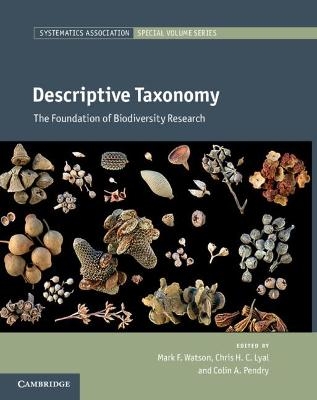
Descriptive Taxonomy
Cambridge University Press (Verlag)
978-0-521-76107-9 (ISBN)
In an age when biodiversity is being lost at an unprecedented rate, it is vital that floristic and faunistic information is up to date, reliable and easily accessible for the formulation of effective conservation strategies. Electronic data management and communication are transforming descriptive taxonomy radically, enhancing both the collection and dissemination of crucial data on biodiversity. This volume is written by scientists at the forefront of current developments of floras and faunas, along with specialists from applied user groups. The chapters review novel methods of research, development and dissemination, which aim to maximise the relevance and impact of data. Regional case studies are used to illustrate the outputs and impacts of taxonomic research. Integrated approaches are presented which have the capacity to accelerate the production of floras and faunas and to better serve the needs of a widening audience.
Mark Watson is Head of the Major Floras research programme at the Royal Botanic Garden Edinburgh (RBGE), where he leads the Flora of Nepal team. He is a taxonomic botanist and expert in floristic research in the Sino-Himalayan region, with over 23 years' experience at RBGE in floristics, fieldwork and biodiversity informatics. Chris Lyal is a researcher at the Natural History Museum in London, with over 40 years' experience in insect taxonomy, including fieldwork in many countries. He has worked on the digitisation of taxonomic literature to address the 'taxonomic impediment' – the shortage of taxonomists and taxonomic tools that hinders work in other areas of biodiversity research and management. Colin Pendry is an editor for the Flora of Nepal based at RBGE. His background is in ecology, and for the last 20 years he has worked as a plant taxonomist. He has extensive experience of fieldwork in the UK, South East Asia, Latin America, the Caribbean and Nepal and is at the forefront of developments in RBGE's fieldwork methods.
List of contributors; Introduction M. F. Watson and C. Lyal; Part I. The Widening Audience: 1. Floras yesterday, today and tomorrow A. G. Miller, M. Hall, M. F. Watson, S. G. Knees, C. Pendry and M. R. Pullan; 2. Current uses and future perspectives for conservation biology B. Collen; 3. The present and future value of Floras for functional ecologists J. Dick, R. Smith and R. Wadsworth; 4. A publisher's perspective: making biodiversity information available and relevant to a wide audience J. Connor; Part II. The Products of Descriptive Taxonomy: 5. Lessons learned from two projects, the Fauna Europaea and the Checklist delle specie della fauna italiana A. Minelli; 6. Flora Europaea and Euro+Med S. L. Jury; 7. Increasing the utility of the regional African Floras D. W. Kirkup, P. Malcolm and A. Paton; 8. Cybertruffle: an on-line resource for mycology D. W. Minter; 9. Zooplankton Identification Manual for North European Seas (ZIMNES) L. C. Hastie; 10. A field guide to the dragonflies and damselflies of Britain and Ireland S. J. Brooks; 11. Sangha Trees: an identification and training guide to the trees of the northern Republic of Congo A. H. Wortley and D. J. Harris; 12. Millennium Seed Bank collector guides D. Hopkins; 13. Training in tropical plant identification D. J. Harris, S. Bridgewater and J.-M. Moutsamboté; 14. Field identification of vectors and pathogens of military significance A. G. Gutierrez; Part III. The Influence of Technology on Data Gathering in the Field: 15. The changing role of collections and field research S. Knapp; 16. Field methods for inventorying insects C. L. Häuser and K. Riede; 17. From seabed to world wide web: an overview of marine zoological sampling, data processing and potential production of digital marine faunas A. L. Allcock and M. Ryan; 18. Advancements in electronic data capture for botanical field research in temperate regions M. F. Watson, A. G. Miller, M. R. Pullan, C. Pendry and S. G. Knees; Part IV. New Technologies: Their Current Use and Future Potential: 19. Extending floras and faunas to include users' views A. L. Weitzman and C. Lyal; 20. Taxa, taxon names and globally unique identifiers in perspective R. Hyam; 21. E-publishing descriptive taxonomy: the convergence of taxonomic journals and databases V. S. Smith; 22. DNA barcoding in floral and faunal research S. E. Miller; Index.
| Erscheint lt. Verlag | 8.1.2015 |
|---|---|
| Reihe/Serie | Systematics Association Special Volume Series |
| Zusatzinfo | 6 Tables, black and white; 11 Plates, color; 25 Halftones, unspecified; 11 Line drawings, unspecified |
| Verlagsort | Cambridge |
| Sprache | englisch |
| Maße | 194 x 253 mm |
| Gewicht | 920 g |
| Themenwelt | Naturwissenschaften ► Biologie ► Botanik |
| Naturwissenschaften ► Biologie ► Ökologie / Naturschutz | |
| ISBN-10 | 0-521-76107-7 / 0521761077 |
| ISBN-13 | 978-0-521-76107-9 / 9780521761079 |
| Zustand | Neuware |
| Haben Sie eine Frage zum Produkt? |
aus dem Bereich


